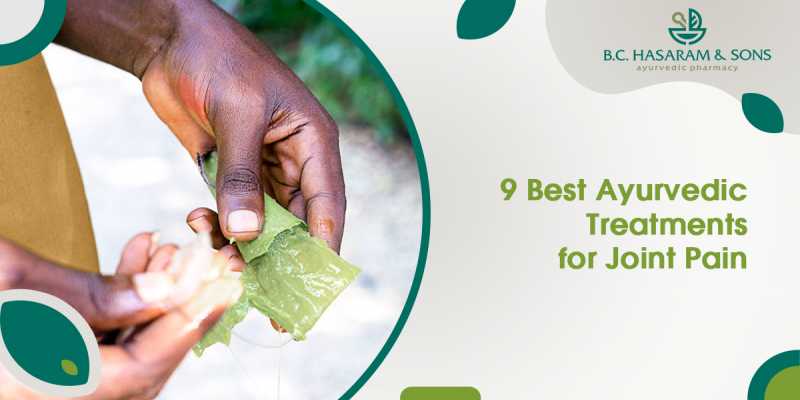
Joint pain usually occurs at the site of joints. The most common cause of joint pain, which generally affects people, is Arthritis. It takes place due to the degeneration of cartilage and ligaments involved in the joints. This usually affects the knee, hip and wrist. Ayurvedic treatment for joint pain takes a holistic approach by treating the root cause of joint degeneration and nourishing the bones, ligaments and cartilages. In addition, Ayurveda focuses on living a healthy and balanced life. Here, we discuss 9 best ayurvedic treatments for joint pain.
9 best ayurvedic treatments for joint pain
- Yogic postures loosen up your muscles and facilitate the strain on your joints. They further develop the flow accordingly, expanding the adaptability of joints. Certain yogic asanas like Trikonasana, Bhujangasana, Garudasan and so on can assist with alleviating the joint aggravation and solidness in joint inflammation. These asanas should be practised consistently alongside your medication for knee torment or any joint aggravation.
- Massage helps alleviate the joint aggravation and relieves the pressure on joints. A massage with herbal oils is a good ayurvedic treatment for joint pain as it offers the added benefit of the individual herbs. They can help with lessening aggravation and work on joint movement. Herbal oils like sesame oil, olive oil, and almond oil are great for bone and joint strength. BC Hasaram’s Kesri Tailum is the best Ayurvedic oil that can be utilized for massaging the knees as it is made from a mixture of many potent oils that provide relief from knee pain in the long run.
- Ayurveda proposes that a sound and balanced diet is important while taking any medication for knee torment or joint agony. Joint pain treatment would be of no utilization on the off chance that you are not following a legitimate eating routine. Ayurveda recommends a non-oily, non-sticky and light-to-digest diet while managing Joint torment. Simple to digest diet which isn’t clogged is great for joints. Conditions like bloating, acid reflux and farting will influence the joints and exasperate joint torment. Fermented foods, sprouted pulses, and bakery food should be taken in less quantity and handled with some restraint.
- Being overweight or obese can come down on the knees and influence the knee joint, causing degeneration and irritation. Any medication for knee torment would be inadequate, assuming the individual is overweight, as the weight will keep on adding the pressure on joints. Consequently, a fat-restricted diet, workout, and intermittent fasting are fundamental to follow along with your joint aggravation treatment.
- Ayurvedic herbs are also very effective in treating joint pain. Some of the herbs include:
Shallaki herb is known to keep your joints strong and ease them from any aggravation. It lessens the irritation as well as helps in decreasing the swelling, and further increases movement. Prevalently known as Boswellia serrata, specialists utilize Shallaki as a substitute for present-day pain relievers.
A typical ingredient found in the kitchen, Turmeric is utilized in Ayurveda for joint pain because of its calming and antioxidant properties. This is a result of its active ingredient ‘Curcumin.’ Adding a pinch of turmeric to the milk and drinking it every day will have a few medical advantages and offer anti-ageing support.
Ashwagandha is an ancient ayurvedic herb utilized in different ayurvedic medicines. This herb has mitigating and antioxidant properties as an immunomodulatory framework. It fortifies the joints and bones when taken consistentlyJanuvasti is an Ancient Ayurvedic warm oil treatment that alleviates joint agony. It is quite effective in treating joint pain and provides relief in the long run.
- One of the ayurvedic remedies for joint pain is the use of lepas. BC Hasaram’s Kesri Marham is a potent treatment for relief from joint pain. It is made from various natural and herbal pain relief oils to relieve joint pain instantly. This balm contains essential herbs that relieve joint pains like shoulders, elbows, knees, neck, foot, back, ankle, and hands.
- A combination of ayurvedic therapies like herbal steam bath, elakizhi, abhyanga, etc., can be done to relieve joint pain. The treatments increase blood circulation, ease pain, condition the joints, and provide strength to the affected area’s joints, muscles, and tissues.
- Acupuncture is an ancient Chinese clinical treatment that includes embedding thin needles into explicit parts of your body. Experts say it works by rerouting energies and reestablishing harmony in your body. It might diminish joint inflammation, and the ACR/AF conditionally suggests it.
Treating joint pain the ayurvedic way.
To prevent joint discomfort, Ayurveda includes many treatments and lifestyle routines. Joint pain and other issues can be avoided by exercising regularly, avoiding tobacco products, eating a well-balanced diet, and maintaining healthy body weight. Regular Abhyanga massages with ayurvedic oils such as BC Hasaram’s Kesri Tailum and Marham are also recommended to maintain joint flexibility, stability, and smooth movement.





